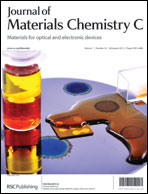The synthesis of a highly ordered mesoporous ternary Mg–Nb oxide by the Evaporation Induced Self-Assembly (EISA) method is presented for the first time. The as-prepared material shows 2D-hexagonal pore periodicity, with unimodal pore size distribution centered at 5.5 nm, and a large surface area (169 m2 g−1). The mechanical properties, determined by means of nanoindentation, are consistent with the presence of ordered domains of honeycomb-like hexagonal pore arrangements, in agreement with electron microscopy observations and N2 sorption isotherm analyses. The dielectric constant of the mesoporous sample, measured at room temperature in the frequency range 1 kHz to 1 MHz, is rather high (κ ∼ 25 at 1 MHz) and correlates well with the κ value of the bulk and the porosity level of this material. Moreover, the thermal stability of the mesoporous magnesium niobate is investigated after air-annealing treatments at different temperatures. While a significant decrease of the surface area is observed for TANN = 650 °C, the mesostructure fully collapses after annealing at 800 °C.

You have access to this article
 Please wait while we load your content...
Something went wrong. Try again?
Please wait while we load your content...
Something went wrong. Try again?


 Please wait while we load your content...
Please wait while we load your content...